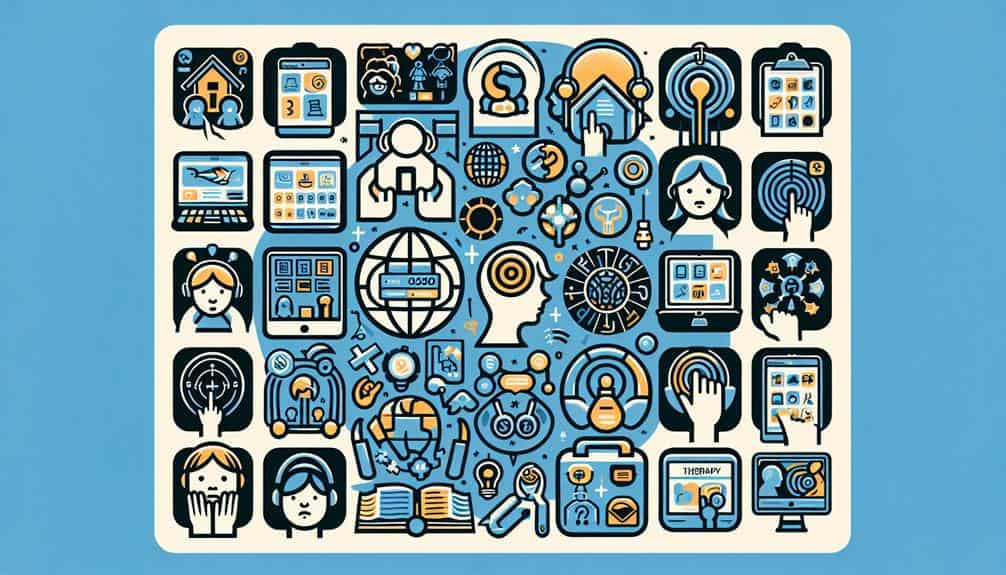Incorporate assistive tech in special needs homeschooling by first identifying specific needs and researching suitable solutions that match your child's learning style. Create a well-organized tech environment with accessibility features and customized tools for individual support. Implement assistive apps that align with your child's goals and provide training for effective use. Develop personalized learning plans with achievable targets and continuous assessments to track progress. Don't forget to involve parents in assessments and seek professional guidance when needed for tailored support and expert advice. Enhancing your child's educational journey through assistive tech is key to their academic success.
Key Points
- Evaluate specific needs and research suitable assistive tech solutions.
- Create an organized, distraction-free workspace with good lighting.
- Customize learning tools to match individual needs and strengths.
- Implement assistive apps with accessibility features and training.
- Develop individualized learning plans with achievable goals and regular assessments.
Identifying Specific Needs
Identifying specific needs is vital in tailoring the right assistive technology solutions for your child's homeschooling journey. A critical first step is conducting a thorough assistive tech evaluation to pinpoint areas where your child may require additional support. This evaluation involves appraising your child's unique learning style, strengths, and challenges. By understanding these factors, you can better match the assistive technology to your child's specific needs.
Special needs identification is key in this process. Whether your child has dyslexia, ADHD, autism, or any other learning challenge, recognizing their individual requirements is fundamental. Each child is different, and what works for one may not work for another. By identifying your child's special needs, you can narrow down the assistive technology options that are most suitable for their homeschooling success.
Researching Suitable Tech Solutions
To find the most effective assistive technology solutions for your child's homeschooling needs, it's essential to thoroughly research suitable tech options that align with their specific requirements.
Start by conducting a tech compatibility assessment to determine which tools will best support your child's learning style and challenges. Consider your budget carefully, as there are a wide range of assistive technologies available at different price points.
Don't hesitate to reach out to parent support groups and online forums for guidance. These communities can provide valuable insights based on their own experiences with different assistive tech solutions. They may recommend specific tools or offer tips on where to find discounts or funding options to make the technology more accessible.
Setting Up Tech Environment
Now let's focus on optimizing the tech environment to best meet your child's homeschooling needs. When setting up your tech environment, consider tech organization and workspace setup to create a conducive learning space.
Keep devices organized and easily accessible, making sure your child can navigate them independently. Designate a specific area for learning, free from distractions, with comfortable seating and good lighting to enhance focus and productivity.
Incorporate accessibility features on devices to cater to your child's specific needs. Adjust font sizes, color contrasts, or enable voice commands to enhance usability. Confirm device compatibility with assistive technologies your child may require.
Test different devices and software to find what works best for their learning style.
Customizing Learning Tools
Consider how you can tailor learning tools to suit your child's unique educational requirements in a homeschooling environment. Here are some ways you can customize learning tools to better support your child's special needs:
- Tech Adaptation:
Explore ways to adapt technology to meet your child's specific needs. This could involve adjusting the font size on educational websites or using screen readers for children with visual impairments. By customizing technology, you can enhance your child's learning experience.
- Learning Modification:
Modify traditional learning materials to accommodate your child's learning style. For example, if your child struggles with reading comprehension, consider incorporating audio versions of textbooks or using tactile materials for hands-on learners. Adapting learning materials can make concepts more accessible and engaging for your child.
- Personalized Tools:
Invest in personalized learning tools such as specialized software or apps designed for children with special needs. These tools can provide targeted support in areas like communication, organization, or academic skills, catering to your child's individual requirements. By personalizing learning tools, you can create a more inclusive and effective homeschooling environment.
Implementing Assistive Apps
When choosing assistive apps for your special needs homeschooling curriculum, consider criteria like accessibility, customization options, and user-friendliness.
It's essential to provide tech training for both you and your child to maximize the benefits of these tools.
App Selection Criteria
Selecting the right assistive apps for your child's homeschooling needs is a crucial step in guaranteeing their success and engagement in learning. To make this process smoother, consider the following criteria:
- App Compatibility and Device Limitations:
Before choosing an assistive app, make sure it's compatible with the devices you have available for your child's use. Check if there are any specific requirements or limitations regarding the operating system or hardware to ensure a seamless experience.
- User Interface and Accessibility Features:
Look for apps with intuitive user interfaces that are easy for your child to navigate independently. Prioritize apps that offer robust accessibility features such as customizable settings for font size, color schemes, audio cues, and compatibility with assistive devices like switches or braille displays.
- Content Relevance and Engagement:
Opt for apps that align with your child's learning goals and interests. Consider interactive elements, engaging visuals, and content that adapts to your child's skill level to keep them motivated and actively participating in the learning process.
Tech Training Strategies
Establish a structured approach to incorporating assistive apps by implementing clear tech training strategies tailored to your child's unique learning needs and abilities. Hands-on learning is essential for effective tech training. Encourage your child to explore the assistive apps actively. Provide interactive training sessions where they can practice using the apps in a supportive environment.
To enhance their understanding, break down the training into manageable steps. Start with basic features before progressing to more advanced functions. This approach can build confidence and prevent overwhelming your child. Additionally, offer regular practice sessions to reinforce learning and allow them to become proficient in using the assistive apps.
Incorporate tech troubleshooting support into the training. Teach your child how to identify and solve common issues they may encounter while using the apps. Equip them with problem-solving skills to navigate technical challenges independently.
Monitoring Progress and Adjusting
As you navigate through your homeschooling journey with assistive technology, utilizing progress tracking tools, creating individualized learning plans, and implementing continuous assessment methods will be key in monitoring your child's development.
These tools allow you to keep a close eye on their progress, make necessary adjustments to their curriculum, and guarantee that their educational needs are being met effectively.
Progress Tracking Tools
Utilize user-friendly progress tracking tools to effectively monitor your child's development and make necessary adjustments in their homeschooling journey. Here are some key tools and strategies to ponder:
- Data Analysis: Choose progress tracking tools that offer detailed data analysis features. These tools can help you identify patterns, strengths, and areas that need improvement in your child's learning process. By analyzing the data provided by these tools, you can make informed decisions about the next steps in your child's homeschooling curriculum.
- Visual Aids: Incorporate visual aids into your progress tracking tools. Visual representations of your child's progress can make it easier for you to track milestones and growth over time. Visual aids can also help your child understand their own progress, fostering a sense of accomplishment and motivation to continue learning.
- Regular Updates: Make sure you regularly update and review the progress tracking tools you use. Consistent monitoring allows you to spot any issues early on and make timely adjustments to your child's educational plan. Stay engaged with the data provided by these tools to ensure your child's homeschooling journey remains effective and tailored to their needs.
Individualized Learning Plans
Developing individualized learning plans that adapt to your child's progress is essential in ensuring their homeschooling journey remains effective and tailored to their unique needs. Parent collaboration is key in this process. By working closely with you, educators can create goals that are specific to your child's abilities and challenges. Setting achievable targets together ensures that the learning plan is realistic and meaningful.
Flexibility is important in adjusting these plans as your child progresses. Regular assessments will help identify areas where modifications are needed. Resource allocation plays a significant role in providing the necessary tools and support for your child to reach their full potential.
It's important to continuously monitor your child's development and adjust the learning plan accordingly.
Continuous Assessment Methods
How can you effectively monitor your child's progress and make necessary adjustments in their individualized learning plan for special needs homeschooling? Parent involvement is key in continuous assessment. Stay actively engaged in your child's learning journey to understand their strengths and areas needing improvement.
To monitor progress effectively, consider the following:
- Data Collection: Keep track of your child's achievements and challenges. Record observations, test results, and feedback from educational activities. This data will help you identify patterns and make informed decisions.
- Remote Assessment: Utilize remote assessment tools to gather information about your child's progress. These tools can provide valuable insights even when working from home, allowing you to adjust the learning plan accordingly.
- Interactive Tools: Incorporate interactive tools into your child's learning process. These tools can make assessments more engaging and effective, providing a dynamic way to track progress and adjust teaching strategies as needed.
Seeking Professional Guidance
When maneuvering the complexities of special needs homeschooling, it's essential to seek professional guidance for tailored support and expert advice. Parent consultation plays an important role in understanding your child's specific needs and goals. By involving professionals early on, such as therapists and educators, you can guarantee a thorough approach to incorporating assistive technology effectively.
A tech assessment conducted by specialists can pinpoint the most suitable tools and devices to aid your child's learning journey. These assessments consider factors like the type of disability, learning style, and individual strengths and weaknesses.
Therapist input is invaluable in aligning assistive technology with your child's educational goals. They can provide insights on how different technologies can enhance specific skills or address challenges your child may face.
Frequently Asked Questions
How Can I Address Sensory Sensitivities With Assistive Tech?
To address sensory sensitivities with assistive tech, explore sensory-friendly apps that cater to individual needs. Additionally, consider utilizing customized sensory tools tailored to your child's preferences. These resources can help create a more comfortable learning environment.
Are There Tech Solutions for Social Skills Development?
To improve social skills, consider using virtual reality for immersive social skills training. Interactive apps offer social interaction simulations. These tech solutions can provide practical and engaging ways to help develop important social skills in a supportive environment.
Can Assistive Tech Be Used for Physical Therapy at Home?
Yes, assistive tech can be a valuable tool for physical therapy at home. Virtual reality can make exercises engaging, while wearable devices track progress. These technologies provide interactive ways to improve physical skills and monitor development.
What Are Some Ways to Teach Time Management Skills?
Imagine time management as a puzzle, where each piece is a task waiting to be placed. Prioritize tasks like precious gems, using visual timers for focus. Embrace calendar apps and daily schedules for organization and success.
How Can I Ensure My Child's Online Safety With Assistive Tech?
To safeguard your child's online safety with assistive tech, set up parental controls for monitoring. Educate them on cyberbullying prevention. Stay informed about their online activities to protect them from potential dangers and provide a safe digital environment.



